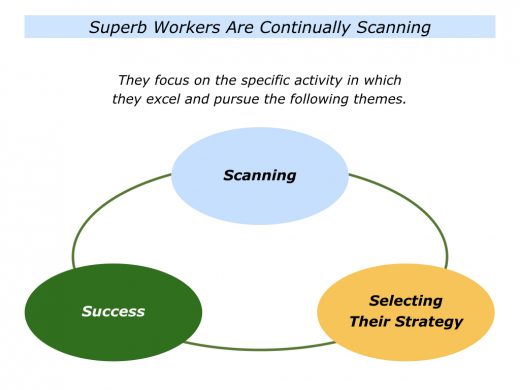
Superb workers focus on the specific activity in which they can excel. They continually go through the process of scanning to see the big picture and see patterns. They select their chosen strategy and then do their best to deliver success.
Different people use different names for seeing what is happening in a situation. Some call it scanning; some call it taking pictures; some call it using their personal radar; some call it having a sixth sense; some call it strategic intuition.
Today the concept of scanning is well-known in sports. Arsene Wenger, the soccer manager, believes it is possible to help players to develop this ability. Later in this article we will be exploring more about his belief that:
Top players have radar in their heads
Arsene’s views mirror the ideas described by Al Siebert, who wrote The Survivor Personality in the 1980s. He said that great workers seem to know what will happen before it happens. He called this gift personal radar.
Al discovered this ability when working with paratroopers. Looking at the hardened professionals, he found that many survivors demonstrated a specific characteristic. He described this in the following way.
During our training I noticed that combat survivors have a type of personal radar always on scan.
Anything that happens, or any noise draws a quick, brief look. They have a relaxed awareness.
I began to realise it wasn’t just luck or fate that these were the few who came back alive. Something about them as people had tipped the scales in their favour.
Peak performers in sports, business and many other fields possess a similar quality. This gives them more time and space to use their repertoire of talents to deliver great results.
Let’s return to Arsene Wenger. Below are extracts from a talk that was published on the website Training Ground Guru. The article also draws on the work done by Geir Jordet, an expert on the topic of scanning. You can discover more via the following link.
Arsene Wenger says a top player has a “head like a radar” and that more work needs to be done on perception and decision making at young ages.
“I came to the conclusion that it is about getting as much information as possible before (getting) the ball. I call that scanning.
“I try to see what happens to a player in the 10 seconds before he gets the ball, how many times he takes information and the quality of information he takes. It depends on the position.
“What is interesting is that very good players scan six to eight times in the 10 seconds before getting the ball and normal ones three to four times. That is a major step for improvement.
“However, more important – you have to analyse the quality of perception and decision making.
“My challenge is to get my players to know which the best choice is and make the optimal decision every time they get the ball.
“The player has to scan and decide. When he has decided he has to make the best possible solution. This means a compromise between risk and the progress of the ball.”
The work Wenger was referring to was by Dr Geir Jordet at the Norwegian School of Sports Sciences.
Jordet is the world authority on ‘scanning’ and completed both his Masters thesis and PhD on the role of vision, perception and anticipation in elite performance.
As part of this, he filmed 250 players and analysed what they did before receiving the ball.
Steven Gerrard was found to be outstanding, conducting 0.61 searches per second; Frank Lampard even better, with 0.62 searches per second; and Barcelona’s Xavi off the scale, with 0.83 searches per second.
Different people are good at scanning in different situations. They may use this skill when working as a crisis manager, retailer, sales person, engineer, coach, educator, financial analyst, problem solver, mentor or in another role.
Looking at your own life and work, are there any specific activities where you do lots of scanning? How do you aim to see the big picture and see patterns? How do you select your chosen strategy and then work to achieve success?
If you wish, try tackling the exercise on this theme. This invites you to do the following things.
Describe the specific activity where you go through the process of scanning and working to achieve success.
Describe the specific things you do to go through the process of scanning, seeing patterns, selecting your strategy and working to achieve success.
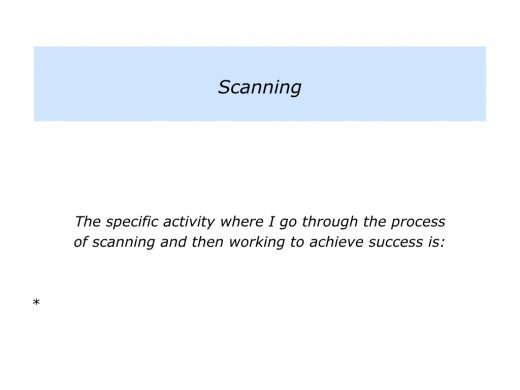
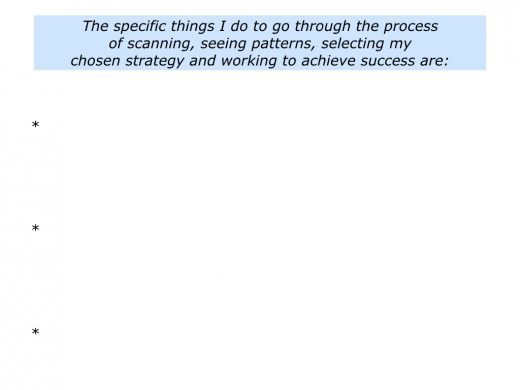
Different people look for different things when they are scanning a situation. Let looks at some examples.
Ellen MacArthur, who sailed solo around the world, talked about reading the waves to anticipate future sailing conditions. She then worked out the strategy for reaching her destination.
Great retailers often spend lots of time watching how customers react to the store layout. They then make the necessary adjustment to increase their sales. One retailer I worked with expressed this in the following way.
Put me in any shop anywhere and I will boost sales. Retail is in my blood. I can immediately see how to display the products and lay out the store to improve profits.
I had difficulty at school, but my parents saw I was good at selling and encouraged me to get a Saturday job. Now I am often used as a consultant to retailers who are doing pilot projects.
Today there is lots of scientific analysis about how people buy. In some cases, however, you just need to watch people and know how to design the store to increase sales.
What do people look for when scanning? Much depends on their chosen activity, but many focus on similar themes. Whether they are a paramedic, footballer, retailer, crisis manager or playing another role, they aim to gather information. They then go through the following steps.
They see the big picture, see patterns and begin to clarify the picture of success.
They clarify the possible options for going forwards – including the pluses and minuses of each option – for achieving the picture of success.
They pursue their chosen strategy and aim do superb work on the way towards achieving the picture of success.
Scanning a situation can give lots of information. The next steps are to decide the best way forwards and then translate this into action. Different people choose different ways to go make good decisions during this stage.
Gary Klein has written several books on this topic, one of which is called Strategic Intuition. Bill Breen wrote an excellent article about Gary’s work for The Fast Company magazine.
He describes how Gary studied people who made decisions when under pressure. Here is an excerpt from the article in which what Gary talks about interviewing firefighters. You can discover more via the following link.
“I noticed that when the most experienced commanders confronted a fire, the biggest question they had to deal with wasn’t ‘What do I do?’ It was ‘What’s going on?’
“That’s what their experience was buying them – the ability to size up a situation and to recognize the best course of action.
“Once they make a decision, they evaluate it by rapidly running a mental simulation. They imagine how a course of action may unfold and how it may ultimately play out.”
The process is akin to building a sequence of snapshots, says Klein, and then observing what occurs.
If everything works out okay, the commanders stick with their choice. But if they discover unintended consequences that could get them into trouble, they discard that solution and look for another one.
They rapidly evaluate each choice on its own merits, even if they cycle through several possibilities. They don’t need the best solution. They just need the one that works.
Gary says that experienced decision makers see a different world from that seen by novices. What they see tells them what they should do. He believes intuition is about perception and then pursuing the strategy that is most likely to succeed.
At the same time, good decision makers keep doing reality checks. They focus on: a) What is working; b) What can be done better and how. They then use this information to make adjustments and achieve success.
Superb workers have good radar in the areas where they excel, but that is only the starting point. They also need to develop a wide repertoire of skills to translate this awareness into action.
Wayne Gretzky, the great ice hockey player, is often quoted as saying that he scored so many goals because:
I skate to the part of the rink where the puck will appear.
He had the radar and the repertoire of skills required to deliver the desired results. This is a characteristic of many great performers.
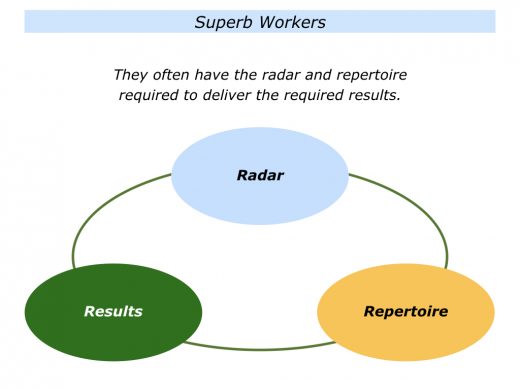
Scanning plays a crucial part in developing one’s radar, so how do people develop this ability? One approach is get into the habit of seeing the big picture and finding patterns.
Different people do this in different ways. Let’s return to the Training Ground Guru article to explore one approach that is used in soccer.
The article describes how Frank Lampard, who was capped more than 100 times for England, was asked why he was so good at scanning. Like many peak performers, he said that he was probably born with the ability.
But there was more to the story. Geir Jordet, the expert on scanning, did more research on how Frank may have developed this natural ability. (His father, Frank Lampard Senior, also played for England.) Here is an extract from the article.
(Jordet) asked West Ham Academy Manager Tony Carr about Lampard’s special skill, and he was illuminating.
“In the first game Frank played for West Ham, his dad would sit in the stands and shout at his son all the time,” Carr explained.
“He’d say the same thing, every time – ‘Pictures! Pictures!’ He just wanted Frank to have a picture in his head before he got the ball.”
Training Ground Guru phoned the former West Ham assistant Frank Lampard Snr to ask more about this.
“I didn’t know it was called scanning, but I knew it was very important, from my own playing career [he played 551 times for West Ham and twice for England],” Lampard Snr said.
“All the best players do this naturally. Or I should say it looks normal, because it will have been drummed into them from a young age.
“It’s crucial, because the higher you go, the less time you have on the ball. You need to gather all of the information you can before receiving the ball, so you can make quick decisions once you have it.”
Andy Etches, Sports Director for elite football virtual reality product Mi Hiepa, told us they have two specific drills based around perception and decision making.
“It’s not just about moving the head,” Etches told TGG, “the crucial thing is that the player sees things and makes decisions based on that.
“We’ve seen that the best players are outstanding on perception and decision making and, as Arsene Wenger says, this is something that needs to be learnt and practiced from a young age.”
Great workers develop the habit of scanning. They focus on a specific activity where they have the ability to perform at their best. They keep seeing the big picture, seeing patterns and making strategic decisions. They then do their best to perform superb work.
Let’s return to the specific activity where you go through the process of scanning. This could be in your personal or professional life.
Looking at this activity, how can you develop your ability to keep scanning and seeing patterns? How can you make good strategic decisions? How can you do superb work and do your best to achieve success?
If you wish, try tackling the exercise on this theme. This invites you to do the following things.
Describe the specific activity where you go through the process of scanning and working to achieve success.
Describe the specific things you can do to keep improving your ability to see the big picture, see patterns, select your chosen strategy and work to achieve success.
Describe the specific things that may happen as a result of taking these steps.
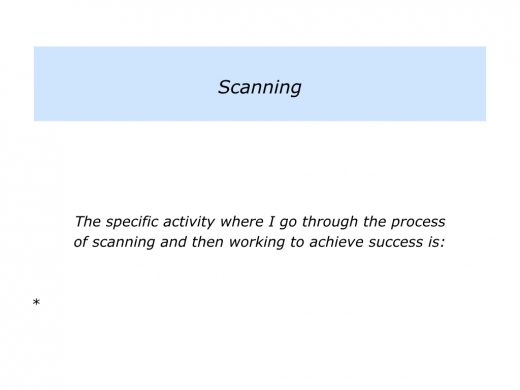
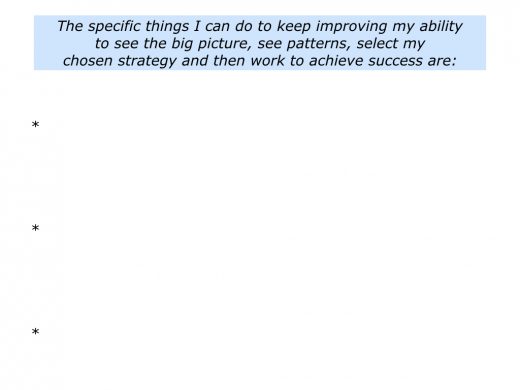
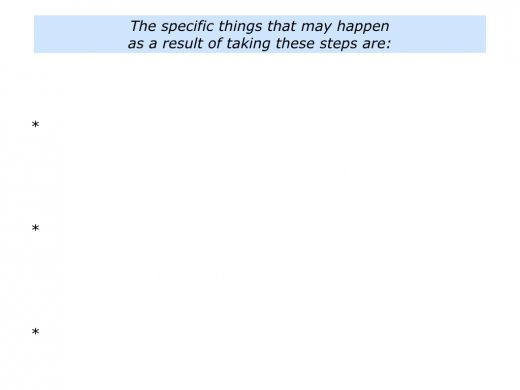






Leave a Reply